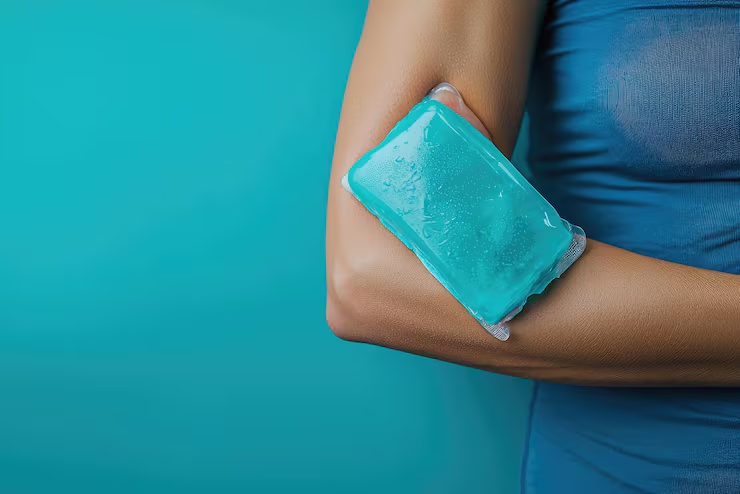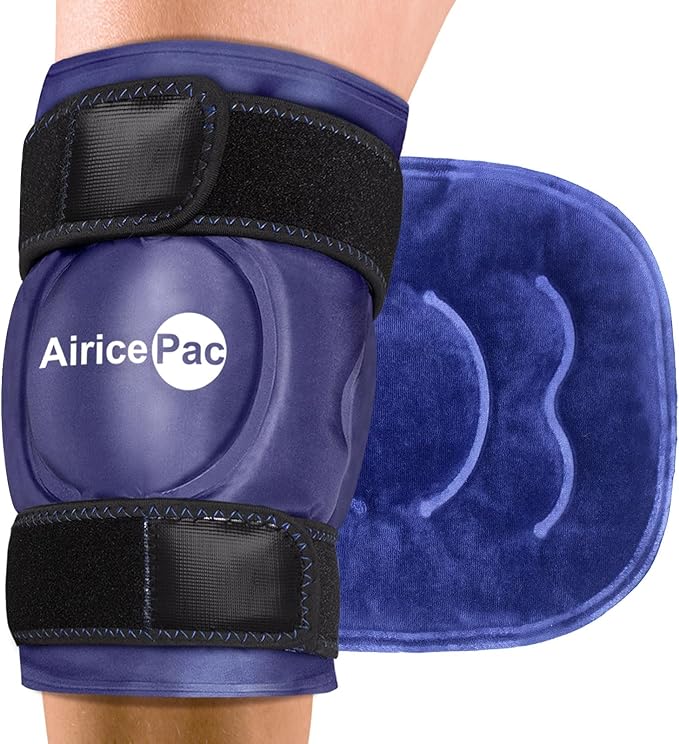- Cold calms freshly irritated areas and may limit swelling. It numbs and eases pain by reducing nerve activity. Use after a new strain or when you overdo it.
- Heat eases stiffness and muscle guarding for comfortable movement. It increases blood flow, reducing stiffness. When muscles work during physical activity, chemical byproducts like lactic acid can build up in the muscles, leading to muscle ache. Heat brings more blood to the area, which helps remove these chemical byproducts and relieve muscle ache.
Most people benefit from trying both (generally not at the same time). Both methods can help reduce pain depending on the situation. Typical session: 10–15 minutes with a thin towel barrier to protect skin.
Understanding Heat Therapy
Heat therapy is ideal for muscle aches, joint stiffness, and improving movement. A warm towel or heating pad increases blood flow, delivering oxygen and nutrients for muscle relaxation, spasm reduction, and pain relief—often 70-80% improvement.
A heating pad device can be used safely to ease muscle spasm and promote relaxation, but always place a towel barrier between the device and your skin to prevent burns.
Warm compresses or heating pads treat sore, stiff muscles from overuse or prolonged sitting. The warmth loosens tissue and eases stretching. Increased blood flow removes lactic acid buildup. Heat therapy 2–3 times daily for 15–20 minutes yields better outcomes. Use around 104-108°F, and avoid overheating.
Understanding Cold Therapy
Cold therapy, or cryotherapy, is best for reducing pain, swelling, and inflammation after injury or overuse. An ice pack or cold compress numbs the area and slows blood flow, helping sore muscles, fresh sprains, or post-activity joint stiffness. Cold numbs the affected tissues and eases pain by reducing nerve activity. Cold therapy also reduces swelling and inflammation in the tissues after injury.
A cold pack constricts vessels, limiting blood flow and swelling while easing pain. It’s a staple for muscle spasms, minor injuries, and flare-ups.
The 3 Pack Types (Pros & Cons)
1) Reusable Gel Pack (Hot or Cold)
Why it’s great: Versatile, simple, inexpensive. You can keep two in rotation—one in the freezer, one ready for the microwave. The flexible gel molds to tricky areas (neck, shoulder, ankle). The outer layer is made of durable plastic, which helps the pack stay flexible and cold.
Best for: Everyday aches, post-workout soreness, minor sprains/strains, “I need one pack that does both heat and cold.”
Pros
- One pack = hot or cold
- Flexible and body-conforming
- Budget-friendly; sizes for small joints or large areas
- Many customers praise the pack’s flexibility, size, and pain relief
Cons
- Heat doesn’t penetrate as “deep” as dedicated heat wraps
- Cheap packs can leak over time (buy from reputable brands)
How to use
- Cold: Freeze 2–3 hours; wrap in a thin towel; apply 10–15 min. The gel pack can easily stick to or stay in place on various body parts due to its flexibility.
- Heat: Microwave per instructions (usually 30–60s); test temp before use
Recommended picks
2) Microwavable Heat Wrap
It offers deep, soothing heat that is beneficial for muscle relaxation, especially for neck and shoulder tension or morning stiffness. Microwavable heat wraps are effective for treating sore muscles and easing muscle spasm.
Best for: Chronic tightness, “desk neck,” low-back stiffness, warming up before gentle mobility.
Pros
- Feels luxurious; encourages relaxation
- No cords or gels; easy to reheat
- Shaped versions for neck/shoulder or low back/hips
Cons
- Heat only (no cold)
- Heavier units may feel too warm for some—start with shorter sessions
How to use
- Microwave per label (usually 60–90s); test temp; apply 10–15 min, check instructions
- For sensitive skin, layer a thin towel the first time
Recommended picks
3) Cold Compression Wrap
Cold with compression, making it suitable for joints experiencing swelling after activity or minor sprains. Straps or a hand pump provide adjustable, gentle pressure to maintain close contact. The wrap is comfortable enough for users to lay on for targeted pain relief, particularly for back or joint pain.
Best for: Knees, ankles, elbows, post-activity flare-ups.
Pros
- Secure fit; you can move around a bit
- Compression + cold can feel more effective on puffy joints
- Reusable sleeves target specific joints
Cons
- Usually cold-only; not a heat device
- A bit pricier than simple gel packs
How to use
- Chill the insert; strap the sleeve snug (not tight)
- Alternate with cold packs for effective relief
- 10–15 minutes; loosen if tingling/too cold
- Reapply cold therapy at certain points, such as every 2 hours, for best results
Recommended picks
How to Combine Packs with a 5-Minute Routine (Fast Relief Plan)
Option A: Heat → Move (for stiffness)
- Apply heat using a microwavable wrap or heated gel pack for 10–12 minutes.
- Perform mobility exercises for 2–3 minutes to loosen muscles and joints:
- Neck: chin tucks and slow rotations
- Back: cat-camel stretches and gentle hip hinges
- Knee/Ankle: easy heel slides and ankle circles
- Return to activity with short walks or light tasks to maintain flexibility.
Option B: Cold → Calm (for fresh irritation)
- Apply cold therapy using a gel pack or cold compression wrap for 10 minutes.
- Offload the affected area briefly by elevating the limb or reducing aggravating activities.
- Move gently within a pain-free range of motion to promote healing without irritation.
Common mistakes (and how to avoid them)
Heat and cold therapy are straightforward methods, yet misuse can lead to burns, nerve damage, and other issues. The following guidelines are important to ensure safety and effectiveness when using ice packs, cold packs, or heating pads:
- Never apply ice packs or cold items directly to the skin. Always use a towel or cloth to avoid nerve damage or frostbite.
- Limit sessions to 15-20 minutes for heat or cold therapy. Allow breaks between sessions to enable skin recovery. Avoid burns or scalding.
- Pick the right pack. Sealable bag with ice, cold pack, warm towel – make sure it fits the area, wraps securely.
- Check the temperature. Your heating pad, cold pack – make sure it’s not too hot, too cold before you put it on the affected area.
- People with health conditions, diabetes especially – consult your doctor before doing heat or cold therapy. Higher risk for complications, so check first.
- Follow safety steps: Towel barrier always, no direct contact, never fall asleep with a pack on.
Buying guide (how we picked)
We prioritize: (1) fit & comfort (contoured designs, flexible gels), (2) temperature retention (stays warm/cold for a full session), (3) durability (stitching, leak-resistant seams), and (4) ease of use (microwave times, freezer readiness, secure straps). If you’re only buying one pack, choose a reusable gel pack—it covers the most scenarios. If your issue is mostly stiffness, add a microwavable heat wrap. If you deal with joint swelling, invest in a cold compression wrap for that joint.
FAQs
Is ice or heat better for back pain?
Try heat for stiffness and cold for fresh irritation. Cold therapy reduces bleeding and reduces joint stiffness by constricting blood vessels, while heat helps relax muscle spasm. Many people alternate on different days. Use what feels better and helps you move.
How often should I use a pack?
1–2 sessions/day is common (10–15 minutes each). Let skin return to normal temperature between sessions. After intense exercise, heat can help by increasing blood flow, which helps remove all the chemicals and byproducts that build up in the muscles.
Can I use heat and cold on the same day?
Yes—just not back-to-back on the same spot. Give the tissue time to normalize in between.
Do compression wraps really help?
For joints that swell after activity, gentle compression with cold often feels more effective than cold alone. Enough blood flow is important for recovery, and blood supply helps remove waste products from muscles.
Disclosure: This page contains affiliate links; we may earn a commission if you make a purchase, at no extra cost to you.
Medical Disclaimer: General information only. Consult a qualified clinician.







